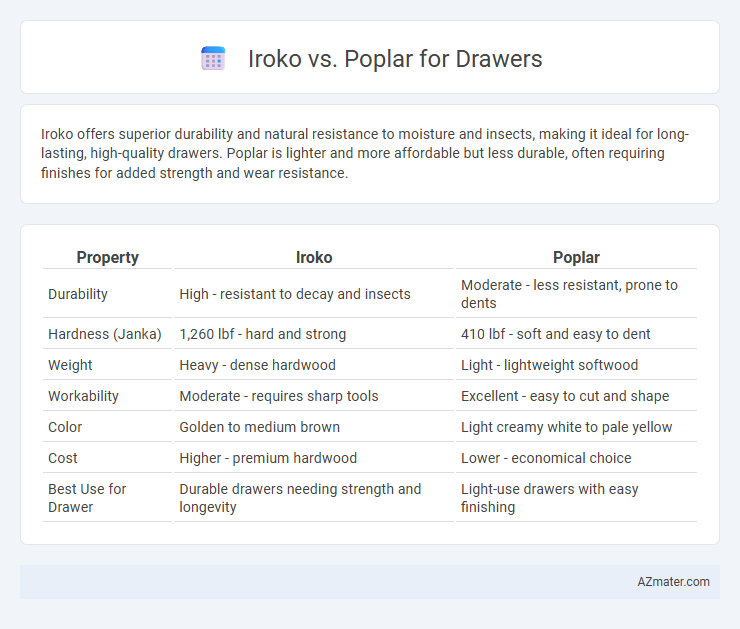Iroko offers superior durability and natural resistance to moisture and insects, making it ideal for long-lasting, high-quality drawers. Poplar is lighter and more affordable but less durable, often requiring finishes for added strength and wear resistance.
Table of Comparison
| Property | Iroko | Poplar |
|---|---|---|
| Durability | High - resistant to decay and insects | Moderate - less resistant, prone to dents |
| Hardness (Janka) | 1,260 lbf - hard and strong | 410 lbf - soft and easy to dent |
| Weight | Heavy - dense hardwood | Light - lightweight softwood |
| Workability | Moderate - requires sharp tools | Excellent - easy to cut and shape |
| Color | Golden to medium brown | Light creamy white to pale yellow |
| Cost | Higher - premium hardwood | Lower - economical choice |
| Best Use for Drawer | Durable drawers needing strength and longevity | Light-use drawers with easy finishing |
Introduction to Iroko and Poplar Woods
Iroko wood, known for its durability and resistance to moisture, features a coarse texture with a yellow to golden brown color that darkens over time, making it ideal for drawer construction in humid environments. Poplar wood, a lightweight hardwood with a fine, even grain and creamy white to light green hue, offers ease of machining and a smooth finish, perfect for painted or decorative drawers. Both woods provide unique benefits, with Iroko excelling in strength and longevity, while Poplar stands out for its versatility and cost-effectiveness in furniture making.
Wood Characteristics: Iroko vs Poplar
Iroko wood is dense, durable, and resistant to rot, making it ideal for long-lasting drawers that can withstand heavy use and moisture exposure. Poplar, on the other hand, is softer and lighter with a fine, even grain, offering ease of machining and a smooth finish but less durability compared to Iroko. The natural golden to brown hues of Iroko contrast with the pale, creamy color of Poplar, influencing drawer aesthetics and suitability depending on design preferences.
Durability and Longevity Comparison
Iroko wood offers exceptional durability and resistance to decay, making it highly suitable for long-lasting drawer construction. Poplar, while more affordable and easier to work with, lacks the density and natural resistance to wear, leading to reduced longevity under heavy use. Choosing iroko ensures superior strength and extended lifespan in drawer applications compared to poplar.
Appearance and Aesthetic Differences
Iroko wood displays a rich golden to dark brown hue with interlocking grain patterns that create a dramatic, textured appearance, making it ideal for drawers seeking a warm, natural luxury. Poplar offers a more subdued, pale cream or light green coloration with a straighter grain, resulting in a smooth, uniform finish suited for painted or stained drawers requiring a clean, understated aesthetic. The striking visual complexity of Iroko contrasts with Poplar's subtlety, influencing drawer design choices based on desired warmth versus neutrality in interior decor.
Workability and Ease of Machining
Iroko offers excellent workability with good shear strength and less tendency to splinter, making it a preferred choice for finely crafted drawers that require durability and smooth finishes. Poplar, being a soft hardwood, is easier to machine and shape with fewer tool wear issues, ideal for cost-effective drawer construction, though it may be less resistant to dents and wear over time. Both woods respond well to sanding and gluing, but Iroko's natural oils may require pre-treatment for better adhesion and finishing in drawer applications.
Weight and Density Considerations
Iroko wood has a density of approximately 640 kg/m3, making it significantly heavier and more durable than Poplar, which has a density around 510 kg/m3. The higher weight of Iroko contributes to stronger drawer construction and enhanced load-bearing capacity. Poplar's lighter weight allows for easier handling and smoother operation in drawers but may compromise long-term durability in heavy-use scenarios.
Cost Comparison: Iroko vs Poplar
Iroko wood is significantly more expensive than poplar due to its durability, density, and rarity, with prices often two to three times higher per board foot. Poplar offers a cost-effective option for drawers, providing reasonable strength and workability at a fraction of Iroko's price. Choosing poplar reduces initial material costs, while Iroko's higher price is justified by superior resistance to wear and moisture.
Suitability for Drawer Construction
Iroko wood offers high durability and resistance to wear, making it highly suitable for drawer construction where strength and longevity are essential. Poplar is softer and easier to work with, providing a smooth finish but may lack the robustness needed for heavy-use drawers. Selecting Iroko enhances drawer stability in high-traffic furniture, whereas Poplar suits lightweight or decorative drawer applications.
Environmental Impact and Sustainability
Iroko wood is a dense hardwood known for its durability and natural resistance to decay, making it a sustainable choice when sourced from responsibly managed African forests. Poplar, a fast-growing softwood, offers a lower environmental impact due to shorter harvest cycles and higher carbon sequestration rates, ideal for eco-friendly drawer manufacturing. Selecting certified Iroko or Poplar ensures reduced deforestation and supports sustainable forestry practices, aligning with environmental conservation goals.
Final Verdict: Which Wood is Best for Drawers?
Iroko offers superior durability and resistance to wear, making it ideal for long-lasting drawers that can withstand heavy use. Poplar is more affordable and easier to work with, but it lacks the hardness and moisture resistance of Iroko. For drawers requiring strength and longevity, Iroko is the best choice, while Poplar suits budget-friendly, light-use applications.

Infographic: Iroko vs Poplar for Drawer
 azmater.com
azmater.com